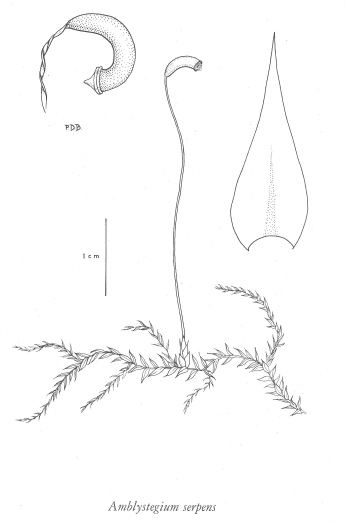Amblystegium serpens (Hedw.) B.S.G
creeping feathermos (amblystegium moss)
Amblystegiaceae
Species Account Author: Wilf Schofield
Extracted from Some Common Mosses of BC
Introduction to the Bryophytes of BC
creeping feathermos (amblystegium moss)
Amblystegiaceae
Species Account Author: Wilf Schofield
Extracted from Some Common Mosses of BC
Introduction to the Bryophytes of BC
SUBTAXA PRESENT IN BC
Introduction
Two subspecies are reported in British Columbia:
1) Amblystegium serpens var. juratzkanum |
Species Information
Species description:
Genus name apparently derived from the blunt operculum; the species name referring to the creeping shoots.
Reproduction:
Sporophytes frequent and often abundant, maturing in spring to early summer; sporophyte reddish brown or with sporangium green and curved when immature.
Distinguishing characteristics:
The slender, soft plants with leaves showing an inconspicuous single midrib are usually sufficient to distinguish this species, especially if it occurs on wood.
Habit:
Reclining slender dark green to reddish-brown, thread-like stems forming interwoven mats, somewhat glossy (under lens); not changing markedly from moist to dry conditions, except that the leaves diverge outward when wet and are against the stem when dry.
Similar Species:
If on rock or soil, several genera might resemble it. Most require examination of microscopic features for discrimination: A. compactum has sharp teeth at the leaf base while A. serpens lacks them; Heteroc/adium macounii has papillose leaf cells when viewed under a compound microscope; most Campylium species that are the same size as the Amblystegium have leaves more spread when wet or dry; Kindbergia praelonga, when small, has a strong midrib in the leaves; Isothecium stoloniferum has toothed leaves, even in the slender forms of the size of A. serpens.
Illustration

If more than one illustration is available for a species (e.g., separate illustrations were provided for two subspecies) then links to the separate images will be provided below. Note that individual subspecies or varietal illustrations are not always available.
Illustration Source: Some Common Mosses of BC
Habitat and Range
Habitat
Frequent in swampy areas and on floodplains on soils, logs and tree bases (especially broad-leafed trees), occasionally on cliff shelves, from sea level (upper edge of saltmarsh) to subalpine forest; occasionally, as a weed, on damp, shaded lawns and in greenhouses. Seldom abundant. Range
World DistributionCosmopolitan in both Northern and Southern Hemispheres, especially in temperate to frigid climates throughout North America.
Status Information
| Scientific Name | Origin Status | Provincial Status | BC List (Red Blue List) | COSEWIC |
|---|---|---|---|---|
| Amblystegium serpens | S4S5 (2015) | Yellow | Not Listed | |
| Amblystegium serpens var. juratzkanum | Native | S4S5 | Yellow | Not Listed |
| Amblystegium serpens var. serpens | Native | S4S5 | Yellow | Not Listed |
BC Ministry of Environment: BC Species and Ecosystems Explorer.
